
| Version | Summary | Created by | Modification | Content Size | Created at | Operation |
|---|---|---|---|---|---|---|
| 1 | Conner Chen | -- | 3751 | 2022-11-28 01:43:35 | | | |
| 2 | Conner Chen | Meta information modification | 3087 | 2022-11-28 07:47:15 | | |
Video Upload Options
1. Introduction
Benjamin Hick (1 August 1790 – 9 September 1842) was a successful English civil and mechanical engineer, art collector and patron;[1] his improvements to the steam engine and invention of scientific tools were held in high esteem by the engineering profession,[2] some of Hick's improvements became public property without claiming the patent rights he was entitled to.[3]
He was born at Huddersfield, and christened in the Independent, dissenter's chapel at Highfield, his parents moving shortly afterwards to Leeds where he was educated. Henry Venn was vicar of Huddersfield parish until 1771.[2][4][5][6]
Hick's aptitude for mechanics and passion for drawing led to an apprentiship in 1804 (age 14) as a draughtsman with Fenton, Murray and Wood[2] at the Round Foundry in Holbeck. The company made steam engines, textile and other machinery; here he was entrusted with the installation of several large steam engines[3] and offered a partnership when his apprenticeship expired.[2] The offer was declined and Hick moved instead to Bolton in 1810[3] to work for Smalley, Thwaites and Company[7] as manager[2] of Rothwell's Union Foundry on Blackhorse Street.[8]
His brother John Hick also trained as an engineer, in 1808 John left Fenton, Murray & Wood to take up the position of "book-keeper and traveller" for John Sturges and Co. at the Bowling Iron Works near Bradford.[9][10]
In July 1820 Hick joined other leading industrialists Isaac Dobson, Thomas Hardcastle and Peter Rothwell together with engineer Joshua Routledge to form the Bolton Gaslight and Coke Company,[11] providing gas for public buildings, street lamps and industrial lighting. With the inevitable fire risk of naked flame, the Great Bolton Trustees and a number of mill owners bought horse-drawn fire engines; Hick became a Trustee of Great Bolton during the early 1820s, he was an Anglican and prominent member of Bolton's Pitt Club, formed 1809 as a "political organisation composed of the admirers of William Pitt", that helped Hick move amongst the middle class social elite of the time.[12][13]
The Dobsons (Isaac and Benjamin), Hick, Rothwell, John Kennedy and others were members of a "prosecution" club (formed 1801), meeting at the Black Horse pub in Bolton, that in 1824 secured an annuity for the inventor and fellow member Samuel Crompton, who also frequented the Inn.[13][14][15] Hick joined the Institution of Civil Engineers in the same year,[3] proposed by Joshua Field, Joseph Farey and James Jones.[16] Also with Rothwell and the Dobsons, Hick was a prominent member of the Black Horse Club, that met "to discuss not only business matters but the most interesting topics affecting that period".[13][14]
Together with many other leading figures from the Bolton area, including those from the Black Horse Club, Hick was a promoter and with Peter Rothwell[13][17] an original shareholder of the Bolton and Leigh Railway that opened 1 August 1828 with the naming of the locomotive Lancashire Witch by Mrs Hulton, wife of the vilified William Hulton JP, High Sheriff of Lancashire and collier.[18] Robert Stephenson was driver of the engine he designed and built[19] with chief engineer George Stephenson,[20] who was a passenger with the other guests.[21] Following the occasion that gathered crowds of 40-50 thousand people, in October 1828, Hick and Rothwell received Robert Peel, then home secretary, as a guest at their foundry.[22]
In 1837 Hick was, among other local figures including Thomas Ridgway (1778–1839),[23] Edward Bolling, John Hargreaves elder (1780–1860) and Jr, a member of the Provisional Committee of the Bolton and Preston Railway. By 1841 Hick was Deputy chairman and a Director with chairman John Hargreaves; the two families (Hick and Hargreaves) were linked by marriage in 1836.[24] Chief engineer was John Urpeth Rastrick and resident engineer Alexander James Adie, son of Alexander Adie inventor of the sympiesometer. The line opened 22 June 1843 after Hick's death, following some problems in its construction,[25] and merged with the North Union Railway Company 10 May 1844. Hick's executorial trustee, solicitor and banker Thomas Lever Rushton (1810–1883), by then a director of the railway, was part of the negotiating committee for the merger.[26][27]
According to the records of Charles Beyer and an appraisal by John Farey, Hick was apparently responsible for pioneering the use of high-pressure and compound steam engines in textile mills, following the designs of Arthur Woolf.[28] Hick's engines should probably be considered best practice for the time c.1841.[29][30]
Locomotives built by Hick were of the best quality, Edward Bury considered them "extremely well made" and they were used by the London and Birmingham Railway for the very first scheme of standardisation of parts.[31]
2. Rothwell, Hick and Rothwell
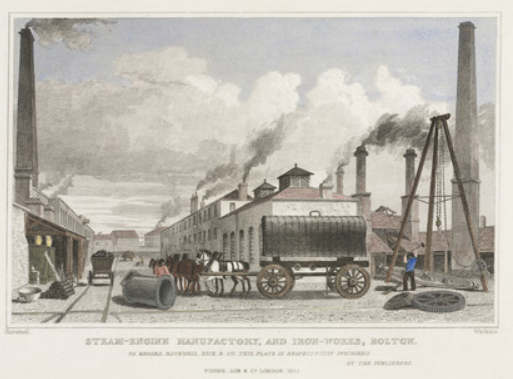
By 1821 Hick was managing partner of the Union Foundry, that later became Rothwell, Hick and Rothwell.[3][33] After Peter Rothwell's death on 2 August 1824, the company continued with Peter Rothwell Jr (1792–1849) as Rothwell, Hick & Co.[34] They made stationary steam engines, (a number of which were featured by John Farey in the second volume of his Treatise on the Steam Engine, 1827) as well as general engineering products including cast iron dockyard cranes.[9] Rothwell, Hick and Rothwell were listed in Baines' directory as supplying steam engines, hydraulic presses, weighing machines, gas light apparatus, mill machinery, sugar mills and constructors of fire proof buildings.[35]
In 1824 when the prodigious and forward looking Swiss engineer Johann Georg Bodmer (anglicised to John George Bodmer) developed his patterns and textile machinery near Bolton he made use of the Rothwell, Hick and Rothwell workshops.[9] Here in the late 1820s with the co-operation of an Italian merchant, Philip Novelli and H. & E. Ashworth, (Henry (1794–1880) and Edmund (1800–1881) Ashworth), they began a project of advanced concept at Egerton Mill[36] to include a spectacular waterwheel[37][38] of 62 feet diameter by 12 feet wide[39] and 110–140 horsepower, completed by Fairbairn and Lillie[40] when Bodmer returned to Europe as a result of ill-health. To aid in the construction it is claimed that Bodmer devised the travelling crane; the Egerton wheel became a tourist destination during the 1830s and 1840s, it was one of the largest in the United Kingdom attracting visits from industrialists and politicians.[41] Benjamin Disraeli was a visitor to the Ashworth mills in 1843.[42][43] By the 1830s Hick had become a highly valued friend of Bodmer, on one occasion arbitrating a patent dispute.[44]
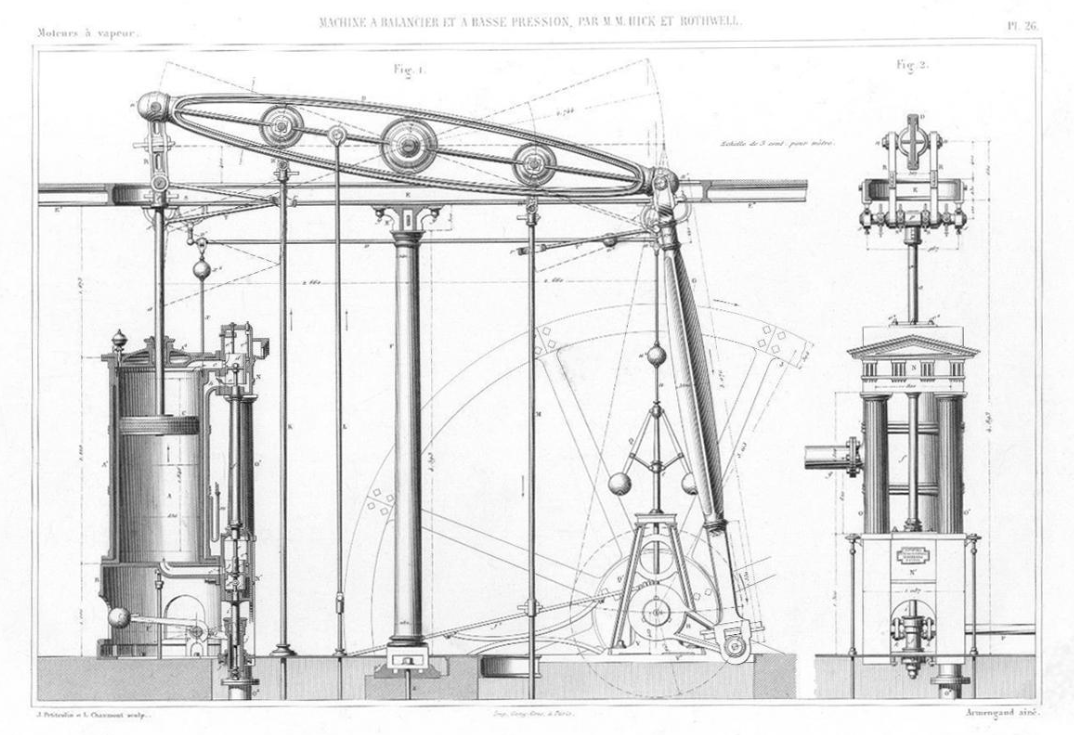
Hick also formed a close friendship with engineer and artist James Nasmyth, in his autobiography Nasmyth refers to Hick as a "most admirable man... whose judgment in all matters connected with engineering and mechanical construction was held in the very highest regard... ingenious", he "contrived and constructed... one of the most powerful hydraulic presses" in existence. Hick was the inventor of the self tightening collar, used universally in hydraulic pressess.[45]
According to Nasmyth, Hick and William Fairbairn were among the most "intelligent and cultivated persons in Lancashire".[46] Hick was an accomplished draughtsman and it is stated that he introduced almost a new era of elegance and design for the exterior forms of steam engines and larger works.[47]
Hick and Rothwell built their first locomotive Union in 1830 for the Bolton and Leigh Railway, they also built Pioneer for the Petersburg Railroad in America[48] and a 2-2-0, the Pontchartrain for the Pontchartrain Railroad, New Orleans in 1832.[49][50]
3. Architecture and Public Works
Hick's talent and reputation as a draughtsman lead to requests for his design of public buildings in Bolton:[2] the Dispensary (1825), Nelson Square (demolished); Cloth Hall, Market Street (demolished); Gas Works (demolished), Water Works[2] and possibly the old Town Hall (1826) in Little Bolton.[51][52][53] The old Town Hall on All Saints Street,[54] and Waterworks cottage (1824), Belmont[55] remain today. The Dispensary is referred to in Pevsner's South Lancashire: The Industrial and Commercial South.[56] Thomas Allen's, Lancashire Illustrated, from Original Drawings. considers, "The gas and waterworks also are eminently deserving of notice. Bolton will long retain memorials of its numerous obligations to the superior genius, public exertions and enterprising spirit of Mr. Benjamin Hick".[57] Hick designed a Gas Pillar and presented it for the opening of Bolton's New Market Place (1826), claimed to be the finest uncovered market in the country; about November 1859 his son John Hick gifted a circular "cattle fountain" round the base,[58] both gaslight and trough remained a feature of the square until 1925,[59][60] the pillar described in 1825 as "a piece of elegant and classical workmanship" and "justly the admiration of persons of taste".[61] Rothwell, Hick and Rothwell contributed elaborate iron work screens with anthemion patterns to Preston Corn Exchange (1822–24).[62]
Hick designed a heating system for Richard Lane's The Oaks (demolished), an imposing Ionic villa conceived in 1838, and home of Quaker, Henry Ashworth.[63] Hick's grandson, also Benjamin Hick (1845–1882)[64] was architect of changes made to Lane's Exchange and Library (1825–29), New Market Place (renamed Victoria Square in 1897)[65] about 1871,[66] his grandfather was among the 80 shareholders of all political and religious persuasions.[33]
4. B. Hick and Sons
In 1814 Benjamin Hick married Elizabeth Routledge (1783–1826) sister of his companion, Joshua Routledge (1773–1829), an engineer and ironmonger living in Bolton, and former manager for Fenton, Murray and Wood.[67] Hick's father-in-law, William Routledge, was a blacksmith and Wesleyan lay minister[68] at Elvington, a village about 8 miles southeast of York in Yorkshire. Joshua Routledge's sons were also engineers; William (1812–1882), a driver of the locomotive Phoenix at the opening of the Liverpool and Manchester Railway 1828, in 1852 master engineer at New Bridge Brass Foundry and partner in Routledge & Ommanney, Salford.[69] Henry (1817–1884), manager of Bolton brass founders J. and W. Kirkham in 1882.[11][70][71][72]
Benjamin Hick had five children, two sons John (1815–1894) and Benjamin (1818–1845)[73] who he trained as engineers; on 10 April 1833[48] they set up their own manufactory, B. Hick and Sons, at the Soho Foundry, Crook Street, Bolton. The firm built the locomotive Soho bought by carrier John Hargreaves with six first class carriages for the Bolton and Leigh Railway,[74] and soon became well known as suppliers to British and foreign railway companies.[34] Three years later Hick's first child and eldest daughter Mary (1813–1878) married John Hargreaves Jr (1800–1874),[24] manufacturer and operator of the Bolton & Leigh and Leigh & Kenyon Junction railways.[34]
After Elizabeth's death he married Hannah Elizabeth Goodyer (c.1791–1862) in 1827 at St Mary's church, Lambeth. Hannah was a daughter of Landon Goodyer who held a position of responsibility in a Fire Office,[75] and sister of Frederick Goodyer who was to become a highly regarded Metropolitan Police Officer under Home Secretary, Robert Peel. The first daughter by Hick's second wife married the only son of Johann Georg Bodmer,[76][77] his youngest daughter married the fourth son of James Bodmer.[78]
Hick was also linked by his mother-in-law Hannah Goodyer, née Schwenck, to the Naval surgeon and novelist William Gilbert, father of William Schwenck Gilbert of Gilbert and Sullivan, his first daughter from his marriage to Hannah Goodyer was named in a similar fashion; Helen Schwenck Hick. Hannah Goodyer's father John Adam Schwenck was treasurer of the congregation of St Mary le Strand,[79] formerly partner in Bourdorff and Schwenck, sugar refiners on Millbank Street, in the parish of St. John the Evangelist, Westminster[80][81] and a director of the Phoenix Fire Office.[82][83]
5. Patron of the Arts
Benjamin Hick was both a serious collector and patron of the arts alongside other wealthy industrialists and bankers from the North of England about mid nineteenth century, including Samuel Ashton, William Bashall of Bashall & Boardman, John Chapman, Henry Cooke, Benjamin Dobson, Sir John Gladstone, John Miller, Thomas Miller Jr of Preston, John Naylor of Leyland & Bullins and Peter Rothwell who favoured English art particularly that depicting nature and history.
A man of "acknowledged taste[3] and judgment"; Hick's private collection built over a period of 30 years "valuable, well known and much admired", comprised works of the Italian, Flemish, Dutch and British Masters. He was regarded as "one of the most liberal of the provincial patrons of Art", generous in his support of the British school, in particular a friend of Henry Liverseege who painted several works for Hick, and "on terms of intimacy" with many artists. The collection consisted of antiques, bronzes, engravings by George Thomas Doo, John Henry Robinson and foreign engravers, marbles, paintings and watercolour drawings.
Foreign works included amongst others those of: Canaletti, Annibale Carracci, Carlo Cignani, Correggio, Aelbert Cuyp, Carlo Dolci, Gerrit Dou, Albrecht Dürer, Sassoferato, Carlo Maratti, Murillo, Parmigianino, Gaspar Poussin, Raffaelle, Paolo Veronese, Egbert van Heemskerck the Younger, Wouwermans, Paul Potter, Peter Paul Rubens, David Teniers, Brawer, Gerard Dow, Anton Raphael Mengs, Jan Miel, Ostate, Backhuysen, Platzer, Claude Joseph Vernet and Van Stry.
Hick's support for the British school extended to: Samuel Austin, Thomas Barker, William Roxby Beverly, John Boaden, William Bradley, Augustus Wall Callcott, George Cattermole, Thomas Sidney Cooper, James Wilson Carmichael, David Cox, James Francis Danby, Samuel Drummond, Charles Lock Eastlake, Copley Fielding, John Rogers Herbert, Henry Howard, John Prescott Knight, William Linton, Henry Liverseege, Frederick Richard Lee, Philip James de Loutherbourg, John Martin, George Morland, Frederick Nash, the Nasmyths, Paul Falconer Poole, Samuel Prout, Thomas Miles Richardson, David Roberts, John Rhodes, William Shayer, Clarkson Frederick Stanfield, Caleb Robert Stanley, Philip Francis Stephanoff, Thomas Stothard, John Tennant, Thomas Uwins, Alfred Vickers, Benjamin West, Richard Westall, David Wilkie, John Wilson, Richard Wilson, John Michael Wright, John Christian Zeitter and others.[1][84][85][86][87]
Having the "greatest reverence for Works of Art and Books", Hick's intention was to establish a Public Picture Gallery in Bolton, with "the conviction that such Works of Art would tend to greatly improve the taste and cultivate the better feeling of the rising generation". He obtained designs for the project, but did not live to see them through. As a boy he looked forward to becoming an Artist.[2]
6. Collection
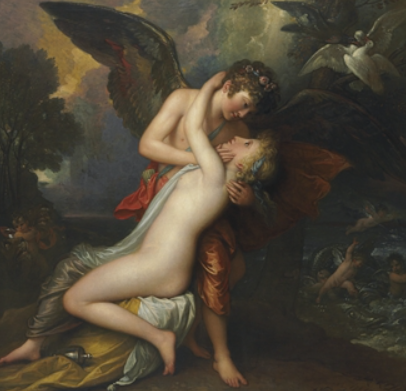
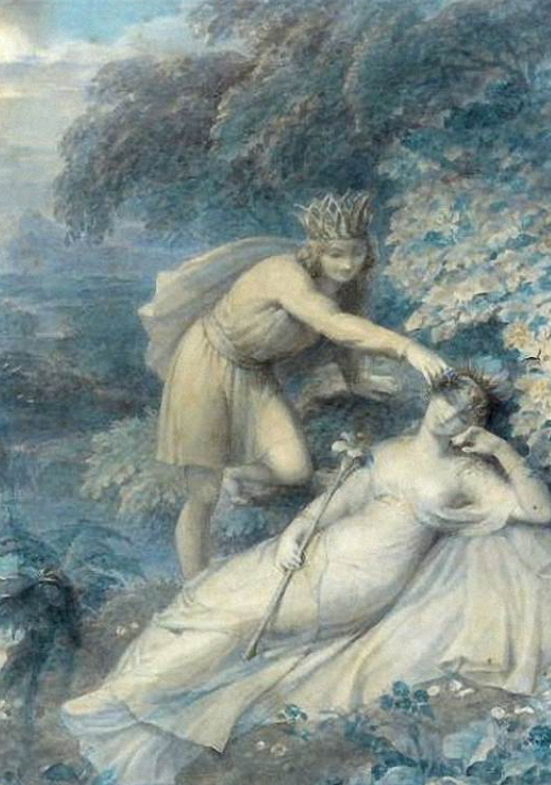
Oberon and Titania by Henry Howard[86] https://handwiki.org/wiki/index.php?curid=1922900

Little Red Riding Hood by Henry Liverseege, 1830[89] https://handwiki.org/wiki/index.php?curid=1781865
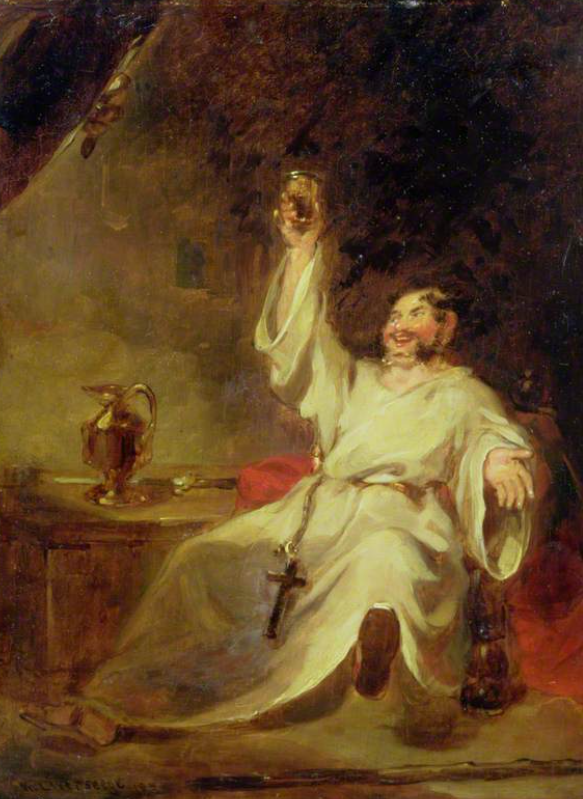
Friar Tuck by Henry Liverseege, 1830[89] https://handwiki.org/wiki/index.php?curid=1649042
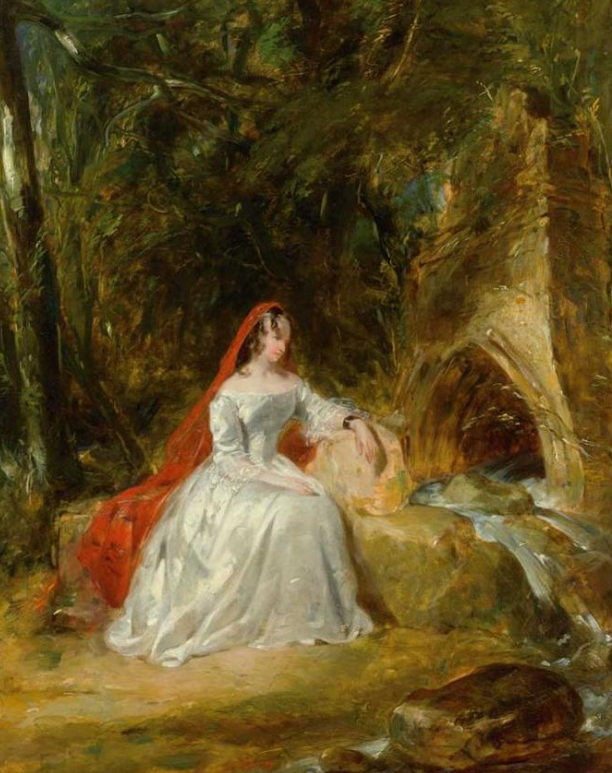
Lucy Ashton by Henry Liverseege, 1830[85] https://handwiki.org/wiki/index.php?curid=1317727
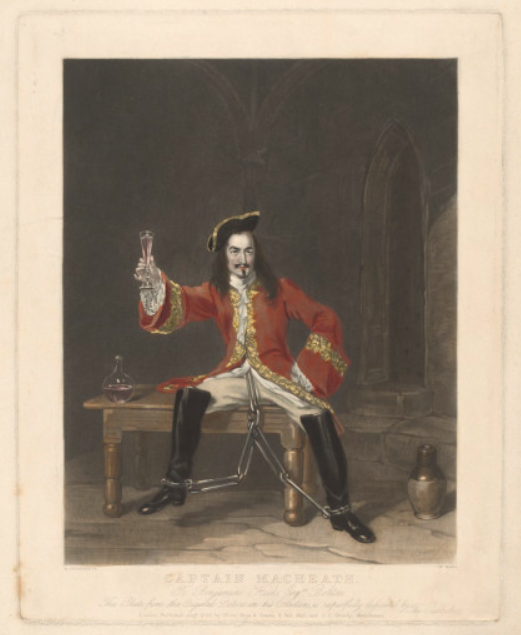
Captain Macheath by Henry Liverseege,[89] mezzotint by William Ward, 1832. https://handwiki.org/wiki/index.php?curid=1478558

Black Dwarf by Henry Liverseege,[86] mezzotint by J.P. Quilley, 1833. The Black Dwarf was a satirical radical journal published January 1817 – 1824 shortly after Walter Scott's The Black Dwarf in December 1816. https://handwiki.org/wiki/index.php?curid=1440743

The Inquiry by Henry Liverseege,[89] mezzotint by J.P. Quilley, 1833. https://handwiki.org/wiki/index.php?curid=1712173

The Orphan by Henry Liverseege,[89] mezzotint and engraving by Samuel Cousins, 1834 depicting Lady Anne Moon (d. 1870). https://handwiki.org/wiki/index.php?curid=1363338
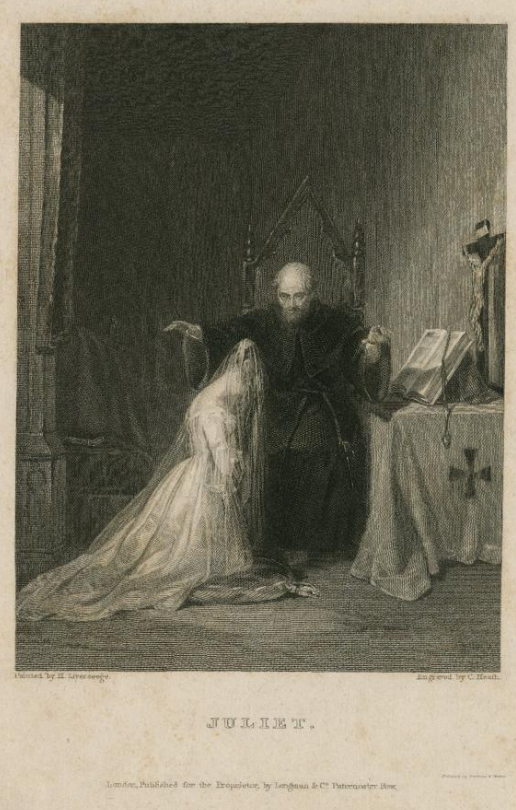
The Benediction by Henry Liverseege,[86] depicting Juliet, engraving by Charles Heath. https://handwiki.org/wiki/index.php?curid=1636083
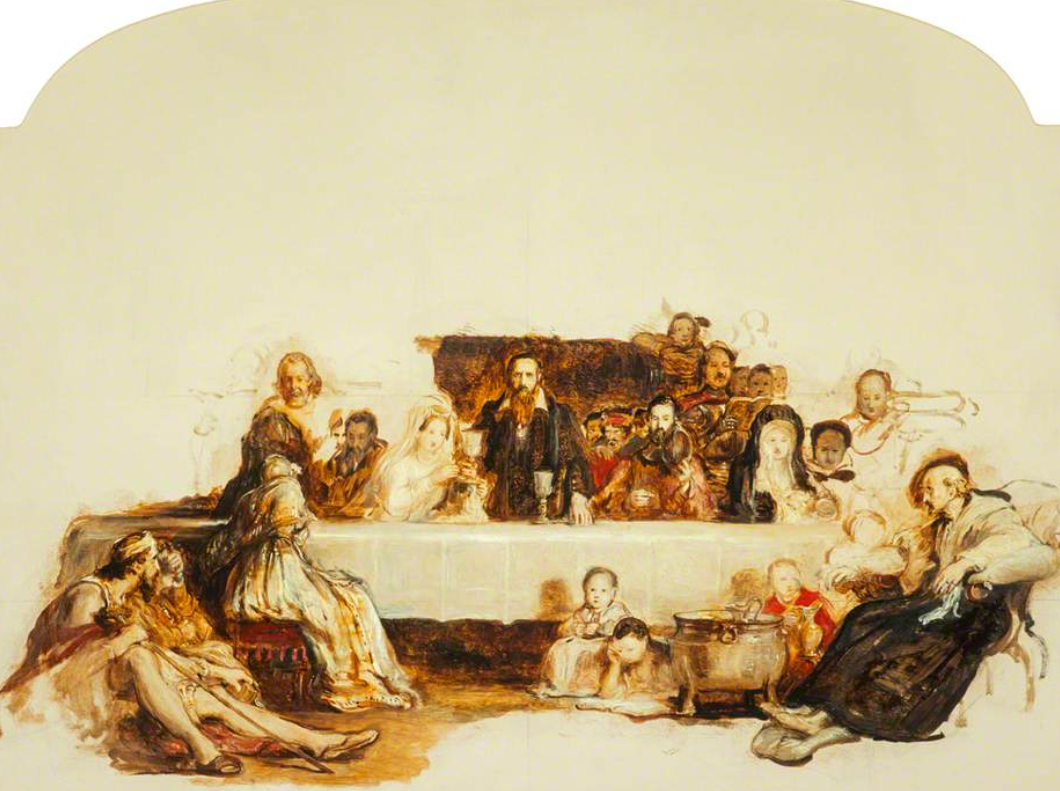
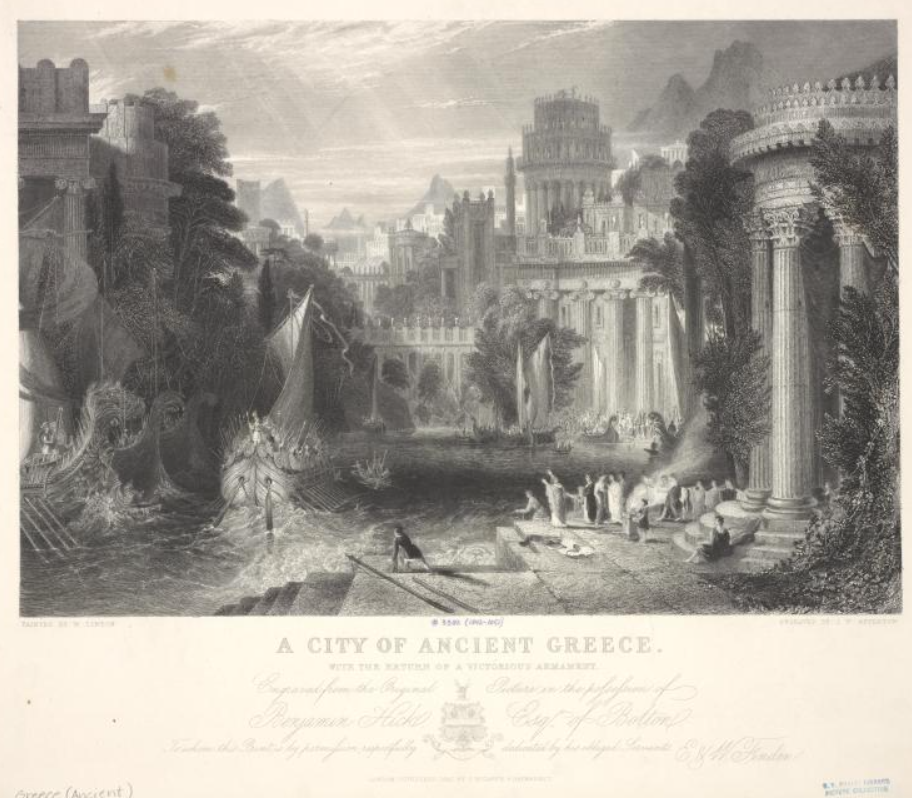
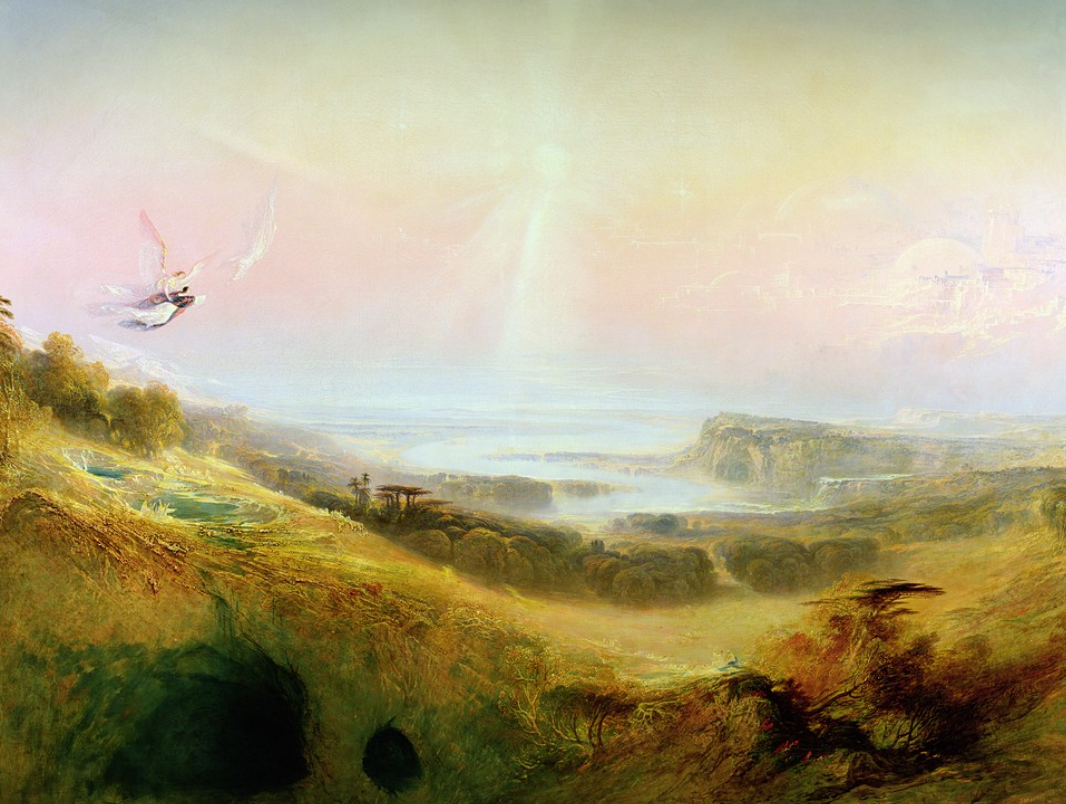
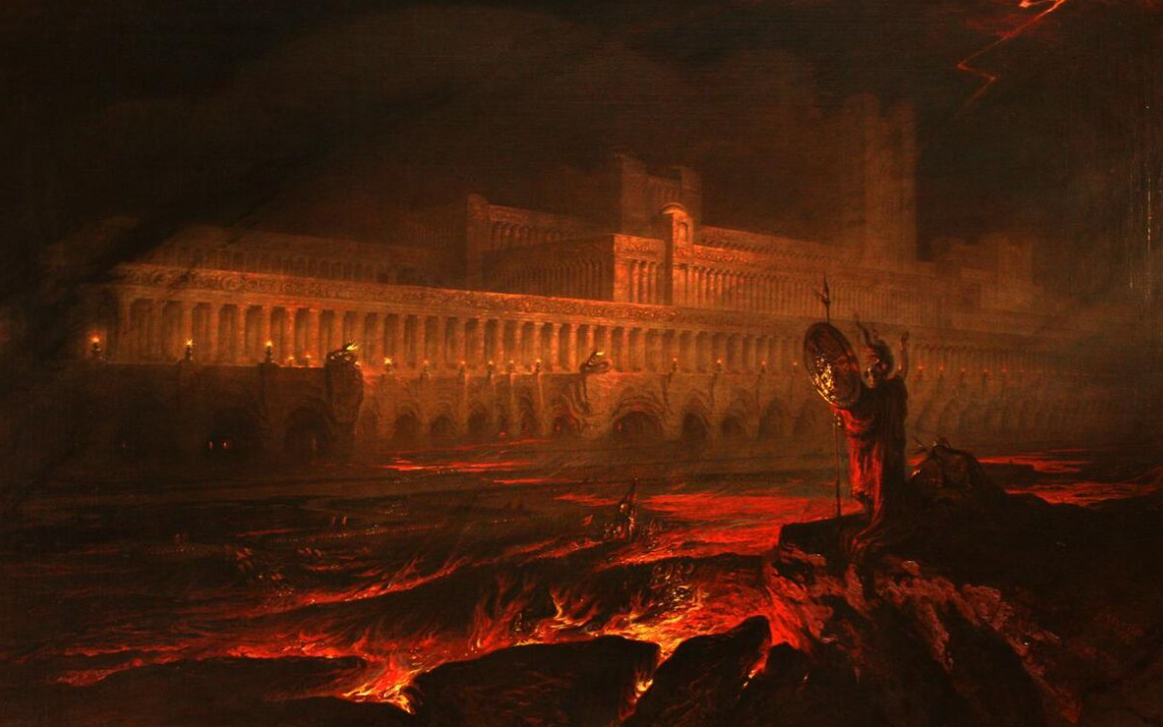
Anon out of the earth a fabric huge
Rose like and exhalation, with the sound
Of dulcet symphonies and voices sweet,
Built like a temple, where pilasters round
Were set, and Doric pillars overlaid
With golden architrave...

Hall i'th' Wood, near Bolton by William Linton https://handwiki.org/wiki/index.php?curid=1746545
7. Death
On 9 September 1842, Hick died suddenly at Bolton from a "disease of the heart", age 52 .[2][95] Following, B. Hick and Son continued under the management of his eldest son, John Hick.
Art works from Benjamin Hick's collection were advertised in January and February 1843 editions of The Art-Union, Athenaeum and Literary Gazette,[96][97][98] then auctioned by Thomas Winstanley & Sons of Liverpool at the Exchange Gallery in Manchester between 21 and 24 February 1843. The sale included John Martin's pair Pandæmonium and The Celestial City and the River of Bliss.[85][94][99][100] Both paintings were bought by Hick from the artist following their exhibition at the Royal Academy of Arts in 1841; Pandæmonium and its frame designed by Martin[101] can be seen at the Louvre. Hick's obituary in the Art-Union appeared with those of John Varley, Lady Callcott and John Berney Crome.[102] Details of the sale were published in the April edition of The Art-Union[87] and May edition of The Gentleman's Magazine.[86]
Friends of Hick from Lancashire: Robert Barlow, Joseph Beckton, Robert Daglish Jr (son of Robert Daglish), Jonathan Hardcastle, John Moore, John Mawdsley, Peter Rothwell and Thomas Lever Rushton formed a committee to see through the production of an engraving from Hick's portrait by George Patten. The picture was entrusted to John Grundy and Henry Cousins undertook the work in mezzotint; proofs were then published at a moderate price,[103] examples can be found today in various museum collections.[104][105][106]
Hick was well respected, despite his family's wish the funeral be "stricty private", more than 500 people "including a great number of influential gentlemen of the neighbourhood", attended his grave; employees of B. Hick & Son gathered nearly £200 for a memorial and despite offers of assistance "resolved unanimously to keep this honour for themselves".[47] Benjamin Hick's memorial in Bolton Parish Church reads:
This monument is erected by a general subscription of his Workmen,
in remembrance of his Christian character
and to record virtues so rare, for future imitation;
that he, though dead, may live again
in the spirit, action, and conduct of those,
who, guided by his character, and stimulated by his example,
will learn to love their neighbour as themselves
and to do good to all men.
He was an affectionate husband,
a kind father, and a sincere friend;
alike distinguished by eminent ability,
and uniform integrity;
genius, in whatever art or science displayed,
even found in him a liberal patron;
He was benefactor to this town,
where his worth will be long appreciated;
and his loss deeply deplored.[2][3][107]
References
- Darcy, C. P. (1976). The encouragement of the fine arts in Lancashire 1760–1860. Oxford Road, Manchester M13 9PL: The Chetham Society, Manchester University Press ND. pp. 7–20, 84, 143–151, 156. ISBN 0-7190-1330-5. https://books.google.com/books?id=X5zYAAAAIAAJ&pg=PA156&lpg=PA156&dq=Benjamin+Hick+patron#v=onepage&q=Benjamin%20Hick%20patron&f=false.
- Darcy, C. P. (1976). The encouragement of the fine arts in Lancashire 1760–1860. Oxford Road, Manchester M13 9PL: The Chetham Society, Manchester University Press ND. pp. 7–20, 84, 143–151, 156. ISBN 0-7190-1330-5.
- Unknown (1 January 1843). "OBITUARY. BENJAMIN HICK, BORN 1790". Minutes of the Proceedings. Institution of Civil Engineers. http://www.icevirtuallibrary.com/doi/pdf/10.1680/imotp.1843.24570. Retrieved 14 December 2012.
- "Highfield Chapel, Huddersfield". The Evangelical Magazine and Missionary Chronicle (University of Chicago: Thomas Ward and Co., Paternoster Row) 21: 458. 1843. https://books.google.com/books?id=BeM6AQAAMAAJ&pg=PA458. Retrieved 18 March 2015.
- "Independent Chapel, Huddersfield". Huddersfield Exposed. https://huddersfield.exposed/wiki/Highfield_Independent_Chapel,_Huddersfield. Retrieved 11 January 2018.
- Redfern, Diane. "Benjamin Hick". dianeredfern.ca. Archived from the original on 7 October 2014. https://web.archive.org/web/20141007031003/http://www.dianeredfern.ca/pafg03.htm#72. Retrieved 19 March 2015.
- "Benjamin Hick". Graces Guide. http://www.gracesguide.co.uk/Benjamin_Hick. Retrieved 14 December 2012.
- "1814–15 Wardle and Bentham's Guide: Bolton". Graces Guide. http://www.gracesguide.co.uk/File:Im1814Wardle-Bolt-Iron.jpg. Retrieved 14 December 2012.
- Chrimes
- "Fenton, Murray and Wood". Grace's Guide Ltd.. https://www.gracesguide.co.uk/Fenton,_Murray_and_Wood. Retrieved 2 January 2018.
- Unknown (January 1888). "THE INVENTOR OF THE SLIDE RULE. STRAY NOTES FROM THE JOURNAL AND DIARY OF JOSHUA ROUTLEDGE, BOLTON". Bolton Journal.
- Taylor, Peter. A Divided Middle Class: Bolton 1790–1850. pp. 9–10, 12.
- P. W. Pilling, Hick Hargreaves and Co., The History of an Engineering Firm c. 1833 – 1939, a Study with Special Reference to Technological Change and Markets (Unpublished Doctoral Thesis, University of Liverpool, 1985). pp. 8, 12.
- Collingwood. "Black Horse Hotel, Blackhorse Street". Blogger. http://lostpubsofbolton.blogspot.co.uk/2014/06/black-horse-hotel-blackhorse-street.html. Retrieved 10 March 2015.
- Daniels and Unwin George (1920). "VI". THE EARLY ENGLISH COTTON INDUSTRY WITH SOME UNPUBLISHED LETTERS OF SAMUEL CROMPTON. Cornell University Library: Manchester, The University press; London, New York [etc.] Longmans, Green & co.. p. 159. https://archive.org/stream/cu31924032476800#page/n199/mode/2up. Retrieved 30 March 2015.
- Membership records. Institution of Civil Engineers.
- "Railways of Bolton". Nic Clews. 2003. http://www.bolton.org.uk/railways.html. Retrieved 8 December 2015.
- Simkin, John. "William Hulton". Spartacus Schoolnet. Archived from the original on 4 September 2011. https://web.archive.org/web/20110904004722/http://www.spartacus.schoolnet.co.uk/PRhulton.htm. Retrieved 14 December 2012.
- Simkin, John. "Lancashire Witch". Spartacus Schoolnet. Archived from the original on 3 December 2012. https://web.archive.org/web/20121203174238/http://www.spartacus.schoolnet.co.uk/RAlancashire.htm. Retrieved 14 December 2012.
- Simkin, John. "Bolton and Leigh". Spartacus Schoolnet. Archived from the original on 7 May 2008. https://web.archive.org/web/20080507205023/http://www.spartacus.schoolnet.co.uk/RAbolton.htm. Retrieved 14 December 2012.
- "1824 The Bolton and Leigh Railway". Daubhill. http://daubhill.webeden.co.uk/#/1824-the-railway/4565790886. Retrieved 14 December 2012.
- CLEGG, JAMES (1888). ANNALS OF BOLTON, HISTORY, CHRONOLOGY, POLITICS, PARLIAMENTARY AND MUNICIPAL POLLS. Allen County Public Library Genealogy Center: BOLTON: THE CHRONICLE OFFICE, KNOWLSEY STREET.. p. 81. https://archive.org/stream/annalsofboltonhi00cleg#page/151/mode/2up/search/HICK. Retrieved 2 May 2015.
- Barker, John. "Thomas Ridgway". http://clanbarker.com/getperson.php?personID=I7744&tree=Br. Retrieved 6 May 2015.
- Redfern, Diane. "Mary Hick". dianeredfern.ca. Archived from the original on 27 November 2015. https://web.archive.org/web/20151127084538/http://www.dianeredfern.ca/pafg04.htm#89. Retrieved 28 November 2015.
- Bedwell, Carolyn (2009). "Preston and Bolton Railway". John Urpeth Rastrick. Archived from the original on 31 December 2013. https://web.archive.org/web/20131231000652/http://www.kylenano.demon.co.uk/rastrick/jur-works/bolton-preston.html. Retrieved 18 January 2013.
- "Thomas Lever Rushton". Links in a Chain - the Mayors of Bolton. Bolton Council. http://www.boltonsmayors.org.uk/rushton-t-l.html. Retrieved 27 January 2014.
- P. W. Pilling, Hick Hargreaves and Co., The History of an Engineering Firm c. 1833 – 1939, a Study with Special Reference to Technological Change and Markets (Unpublished Doctoral Thesis, University of Liverpool, 1985). pp. 87–90, 95.
- Hills, Richard L. (1993). "6:Such unbounded power". Power from Steam: A History of the Stationary Steam Engine (illustrated, reprint ed.). Cambridge University Press. pp. 118–119. ISBN 9780521458344. https://books.google.com/books?id=t6TLOQBhd0YC&pg=PA118&lpg=PA118&dq=benjamin+hick+compound&source=bl&ots=Bjz5tqsDJr&sig=zjubePTFcTQ-ukW0_Au3ogMZa5s&hl=en&sa=X&ved=0ahUKEwjZ2rrboOHNAhXLAsAKHSs0B-UQ6AEINzAE#v=onepage&q=benjamin%20hick%20compound&f=false.
- Castaldi and Nuvolari Carolina and Alessandro (November 2003). Technological Revolutions and Economic Growth: The "Age of Steam" Reconsidered. Eindhoven University of Technology. pp. 18–19. http://www.sussex.ac.uk/Units/spru/events/KP_Conf_03/documents/Nuvolari.pdf. Retrieved 7 July 2016.
- NUVOLARI and VERSPAGEN ALESSANDRO and BART (2009). "Technical choice, innovation, and British steam engineering, 1800–50". Economic History Review (Blackwell Publishing) 62 (3): 703. https://core.ac.uk/download/files/153/6527082.pdf. Retrieved 7 July 2016.
- "EDWARD BURY, 1794 – 1858". http://www.geocities.ws/kentmuseum/BURY.htm. Retrieved 1 August 2016.
- "ANTIQUE PRINTS OF BOLTON". Ash Rare Books. http://www.ashrare.com/bolton_prints.html. Retrieved 2 October 2014.
- Taylor, Peter. A Divided Middle Class: Bolton 1790–1850. p. 10.
- Marshall
- Baines, Parson, Edward, William (1824). History, directory and gazetteer of the county palatine of Lancaster. The directory department by W. Parson. [With Illustrations]. Oxford University: WM. WALES & Co. ADVERTISER-OFFICE, 68 CASTLE STREET. p. 551. https://books.google.com/books?id=LvYNAAAAQAAJ&pg=PA551&lpg=PA551&dq=baines+rothwell+hick+and+rothwell&source=bl&ots=zqR5NQvr2V&sig=knYfFVYLoquUXF1MTAbsIdyOf7A&hl=en&sa=X&ei=2qUtVMGyH6Ou7AaU0oHgCg&ved=0CEwQ6AEwBg#v=onepage&q=baines%20rothwell%20hick%20and%20rothwell&f=false. Retrieved 2 October 2014.
- Ashmore, Owen (1982). The Industrial Archaeology of North-West England. Manchester University Press. p. 144. ISBN 978-0-7190-0820-7. https://books.google.com/books?id=pXa7AAAAIAAJ&pg=PA144&lpg=PA144&dq=egerton+waterwheel+110#v=onepage&q=egerton%20waterwheel%20110&f=false.
- "The Parish of Christ Church, Walmsley". Lancashire OnLine Parish Clerk Project. Bolton & District Family History Society, 1984. FHL film #1656927, part of Item 13. http://www.lan-opc.org.uk/Bolton-le-Moors/Walmsley/christchurch/index.html. Retrieved 29 December 2012.
- Egerton Conservation Area. Bolton Metropolitan Council Environment Department. p. 5. http://www.bolton.gov.uk/sites/DocumentCentre/Documents/EgertonCA.pdf.
- Lewis, Samuel, ed (1848). A Topographical Dictionary of England. Tunstead – Tuxford (Turton): Institute of Historical Research. pp. 401–404. http://www.british-history.ac.uk/report.aspx?compid=51357.
- Musson, Albert Edward; Robinson, Eric (1969). Science and Technology in the Industrial Revolution. Manchester University Press. pp. 481–482. ISBN 978-0-7190-0370-7. https://books.google.com/books?id=0c-8AAAAIAAJ&pg=PA482&lpg=PA482&dq=egerton+waterwheel&ved=0CDIQ6AEwAQ#v=onepage&q=egerton%20waterwheel&f=false.
- "A history of the Ashworth family". Egerton Village Online – Bolton Lancashire. http://egertonvillage.medianewsonline.com/modules.php?name=News&file=article&sid=7. Retrieved 29 December 2012.
- Grindon, Leo Hartley (1892). "Footnotes [22"]. LANCASHIRE, HISTORICAL & PICTORIAL NOTES. SEELY & CO., LIMITED. http://www.mirrorservice.org/sites/gutenberg.org/4/0/5/8/40584/40584-h/40584-h.htm#FNanchor_22_22.
- Roberts, F. David (2002). The Social Conscience of the Early Victorians. Stanford University Press, Stanford, California. p. 68. ISBN 0-8047-4532-3. http://graduateinstitute.ch/files/live/sites/iheid/files/sites/mia/shared/mia/cours/IA023/Week%204/Roberts_The_Social_Conscience_of_the_Early_Victorians.pdf. Retrieved 11 November 2015.
- Unknown (1 January 1869). "OBITUARY. JOHN GEORGE BODMER, 1786–1864". Minutes of the Proceedings. pp. 573–608. http://www.icevirtuallibrary.com/content/article/10.1680/imotp.1869.23105. Retrieved 16 December 2012.
- Hick, John (1884). "EXPERIMENTS ON THE FRICTION COLLARS IN HYDRAULIC PRESSES". Reprinted from ("THE ENGINEER") (University of Michigan: E & F. N. SPON CHARING CROSS.) (Second Edition). https://archive.org/stream/experimentsonfr00hickgoog#page/n4/mode/2up. Retrieved 18 March 2017.
- Nasmyth, James (1883). James Nasmyth engineer: an autobiography, Edited by Samuel Smiles. John Murray of Albemarle Street, London. pp. 184, 207, 244, 434. http://www.gracesguide.co.uk/James_Nasmyth_by_James_Nasmyth.
- "OBITUARY. BENJAMIN HICK, ESQ,. OF BOLTON.". The Art-Union 5: 10. 1 January 1843. https://books.google.com/books?id=CGZRAAAAYAAJ&pg=PA10&lpg=PA10&dq=Benjamin+hick+we+have+to+record+with+deep+regret+the+art+union#v=onepage&q=Benjamin%20hick%20we%20have%20to%20record%20with%20deep%20regret%20the%20art%20union&f=false. Retrieved 23 January 2014.
- Skeat, W. O.; Marshall, John (1974). Catalogue: Hick hargreaves Exhibition of early locomotive drawings. Rockliff Bros. Ltd., Long Lane, Liverpool L9 7BE.
- Hennick, Louis C.; Charlton, Elbridge Harper (1965). The Streetcars of New Orleans, Volume 2 of Louisiana, its street and interurban railways. Pelican Publishing. p. 5. ISBN 1455612596. https://books.google.com/books?id=X2Zu8CSRFZAC&pg=PA5&lpg=PA5&dq=pontchartrain+railroad+hick&source=bl&ots=SGQSYoSVlt&sig=EazA6JsPXMlPuFMXrUJKycJhU5A&hl=en&sa=X&ei=4GzyU-q1NomI7AbP_oD4BQ&ved=0CDcQ6AEwBA#v=onepage&q=pontchartrain%20railroad%20hick&f=false.
- Guilbeau, James (2011). St. Charles Streetcar, The: Or, the New Orleans & Carrollton Railroad Louisiana Landmarks (illustrated ed.). Pelican Publishing Company, Inc.. p. 18. ISBN 1879714027. https://books.google.com/books?id=oAgxzQPeAjwC&pg=PA18&lpg=PA18&dq=pontchartrain+railroad+hick&source=bl&ots=a76RANrcqe&sig=jnyzCVvqbxjRf_OWzpXzzuDAb9Q&hl=en&sa=X&ei=4GzyU-q1NomI7AbP_oD4BQ&ved=0CC8Q6AEwAg#v=onepage&q=pontchartrain%20railroad%20hick&f=false.
- South Kensington Museum (1868). Catalogue of the Third and Concluding Exhibition of National Portraits Commencing with the Fortieth Year of the Reign of George the Third and Ending with the Year MDCCCLXVII: On Loan to the South Kensington Museum, April 13, 1868. University of Michigan: Strangeways and Walden. https://books.google.com/books?id=X0HKTKFPKWUC&pg=PA87&lpg=PA87&dq=john+hick+ill-%20health&source=bl&ots=D9wmHu9pc0&sig=0yp_xV0WS36OMrLnSN_SXQWZQdE&hl=en&sa=X&ved=0ahUKEwjmouvJ_8LJAhWGKx4KHeo_CO4Q6AEIPDAH#v=onepage&q=john%20hick%20ill-health&f=false. Retrieved 4 December 2015.
- CLEGG, JAMES (1888). ANNALS OF BOLTON, HISTORY, CHRONOLOGY, POLITICS, PARLIAMENTARY AND MUNICIPAL POLLS. Allen County Public Library Genealogy Center: BOLTON: THE CHRONICLE OFFICE, KNOWLSEY STREET.. p. 79. https://archive.org/stream/annalsofboltonhi00cleg#page/147/mode/2up. Retrieved 2 May 2015.
- Hartwell, Clare; Hyde, Matthew; Pevsner, Nikolaus (2004). Lancashire: Manchester and the South-East Buildings of England Pevsner architectural guides The Buildings of England, Ireland, Scotl (illustrated, revised ed.). Yale University Press. p. 149. ISBN 0300105835. https://books.google.com/books?id=fLJSTdnCgqUC&pg=PA149&lpg=PA149&dq=benjamin+hick+old+town+hall&source=bl&ots=pkuSNutJtQ&sig=WszwkZIl80pGqMtJM4-lzpcWFy8&hl=en&sa=X&ei=waEeVPbSMO6d7gamn4CADA&ved=0CC0Q6AEwAg#v=onepage&q=benjamin%20hick%20old%20town%20hall&f=false. Retrieved 21 September 2014.
- Linford, Simon. "The Project". Linford: Developing Heritage. http://www.littleboltontownhall.com/page/the-project. Retrieved 21 September 2014.
- "Waterworks Cottage, North Turton". BritishListedBuildings.co.uk. http://www.britishlistedbuildings.co.uk/en-440679-waterworks-cottage-north-turton-. Retrieved 15 October 2014.
- Pevsner, Nicholas (1969). South Lancashire: The Industrial and Commercial South Buildings of England Volume 1 of Lancashire, Nikolaus Pevsner Pevsner Architectural Guides Pevsner architectural guides: The buildings of England The Buildings of England, Ireland, and Scotland Seriesand Commercial South (illustrated, reprint, revised ed.). Yale University Press. p. 82. ISBN 0300096151. https://books.google.com/books?id=fEiDNbsxEXsC&pg=PA82&lpg=PA82&dq=benjamin+hick+dispensary&source=bl&ots=bEgRbiS4WZ&sig=KT7ZleutOARk9LLkcRSHXl3X3oY&hl=en&sa=X&ei=fKAeVJizN4Hg7QbxtoHwCw&ved=0CD0Q6AEwBA#v=onepage&q=benjamin%20hick%20dispensary&f=false. Retrieved 21 September 2014.
- Allen, Thomas (1832). Lancashire Illustrated, from Original Drawings. Oxford University: H. Fisher, R. Fisher and P. Jackson. p. 76. https://books.google.com/books?id=rmYGAAAAQAAJ&pg=PA76&lpg=PA76&dq=Thomas+Allen%27s,+Lancashire+Illustrated,+from+Original+Drawings.+benjamin+hick&source=bl&ots=01_ljqr27G&sig=J9iJtIiZwP6P8nDyaZOjljf62iU&hl=en&sa=X&ei=zJItVJXJN6af7gatvYHQDA&ved=0CCcQ6AEwAQ#v=onepage&q=Thomas%20Allen%27s%2C%20Lancashire%20Illustrated%2C%20from%20Original%20Drawings.%20benjamin%20hick&f=false. Retrieved 2 October 2014.
- "Water, water, everywhere - and quite a lot to drink, too!". The Bolton News. 17 September 2002. http://www.theboltonnews.co.uk/news/5946519.Water__water__everywhere___and_quite_a_lot_to_drink__too_/?ref=arc. Retrieved 7 September 2017.
- Macdonald, Steve. "The New Market Square (1826-1871)". Bolton Environment Education Project. http://www.ss-osands.org.uk/ssosands/beep/markets/new_market_square.htm. Retrieved 2 October 2014.
- "Around the Town Hall, Victoria Square". http://bolton.webeden.co.uk/. Retrieved 7 September 2017. "The ornate gas lamp and the circular trough surrounding its base were removed in 1925 because their presence would have detracted from the effectiveness of the War Memorial’s setting and they were considered a menace to traffic."
- CLEGG, JAMES (1888). ANNALS OF BOLTON, HISTORY, CHRONOLOGY, POLITICS, PARLIAMENTARY AND MUNICIPAL POLLS. Allen County Public Library Genealogy Center: BOLTON: THE CHRONICLE OFFICE, KNOWLSEY STREET.. p. 78. https://archive.org/stream/annalsofboltonhi00cleg#page/145/mode/2up/search/HICK. Retrieved 2 May 2015.
- Historic England. "Details from listed building database (1292350)". National Heritage List for England. https://HistoricEngland.org.uk/listing/the-list/list-entry/1292350. Retrieved 2 October 2014.
- Kingsley, Nicholas (2 April 2016). "Ashworth of Birtenshaw, The Oaks and Horsley Hall". Nicholas Kingsley. http://landedfamilies.blogspot.co.uk/2016/04/212-ashworth-of-birtenshaw-oaks-and.html. Retrieved 11 May 2016.
- Redfern, Diane. "Benjamin Hick". dianeredfern.ca. Archived from the original on 4 March 2016. https://web.archive.org/web/20160304044001/http://www.dianeredfern.ca/pafg05.htm#90. Retrieved 26 November 2015.
- Cropper, Peter. "Oh Bolton, Bolton..." (pdf). Peter Cropper. p. 1. Archived from the original on 2 September 2016. https://web.archive.org/web/20160902063654/http://petercropper.co.uk/writing/Bolton.pdf. Retrieved 5 May 2015.
- Historic England. "Details from listed building database (1388292)". National Heritage List for England. https://HistoricEngland.org.uk/listing/the-list/list-entry/1388292. Retrieved 4 November 2014.
- Knott, John V. (October 1995). "Joshua Routledge 1775–1829". Journal of the Oughtred Society 4 (2): 25.
- Register of the Members in the Wesleyan Society from 1787 to the Year 1791 (Borthwick Institute for Historical Research, University of York, Yorkshire, MRC 1/1-5).
- Redfern, Diane. "William Routledge citations". dianeredfern.ca. http://www.dianeredfern.ca/pafc03.htm#52C1. Retrieved 2 October 2014.
- Barton, B. T. (1883). "Historical Gleanings of Bolton and District. THE ROUTLEDGE FAMILY". Daily Chronicle: 124–125.
- Barton, B. T. (1883). "Historical Gleanings of Bolton and District. FURTHER PARTICULARS OF THE ROUTLEDGE FAMILY". Daily Chronicle: 137–138.
- Redfern, Diane. "Henry Routledge citations". dianeredfern.ca. http://www.dianeredfern.ca/pafc02.htm#46C1. Retrieved 2 October 2014.
- Redfern, Diane. "Benjamin Hick". dianeredfern.ca. Archived from the original on 4 March 2016. https://web.archive.org/web/20160304044001/http://www.dianeredfern.ca/pafg05.htm#90. Retrieved 20 October 2015.
- Lewis, David (2003). Nevell, Dr. Michael. ed. "Hick, Hargreaves & Co, Engineers, Soho Foundry, Bolton, 1833 - 2002". Industrial Archaeology Northwest (CBA North West Industrial Archaeology Panel) 1.3 (3): 18. ISSN 1479-5345. http://www.worldcat.org/issn/1479-5345
- Stanley, Clifford R.. "A Centenary Tribute to Frederick Goodyer, Leicestershire's First Chief Constable 1836–1876". T.L.A.H.S Vol. L1. Leicestershire Archaeological and Historical Society. pp. 17, 18. http://www.le.ac.uk/lahs/downloads/GoodyerPagesfromvolumeLI-3.pdf. Retrieved 17 January 2013.
- Unknown (1 January 1903). "OBITUARY. GEORGE RUDOLPH BODMER, 1853–1902". Minutes of the Proceedings. pp. 427–428. http://www.icevirtuallibrary.com/content/article/10.1680/imotp.1903.18201. Retrieved 16 December 2012.
- "Manchester Courier and Lancashire General Advertiser, 19 Jul 1851". http://www.genesreunited.co.uk/searchbna/results?memberlastsubclass=none&searchhistorykey=0&keywords=benjamin%20bodmer&county=greater%20manchester,%20england&from=1850&to=1899. Retrieved 2 October 2014.
- "Leicester Chronicle, 4 Jun 1853". http://www.genesreunited.co.uk/searchbna/results?memberlastsubclass=none&searchhistorykey=0&keywords=benjamin%20bodmer&page=1. Retrieved 2 October 2014.
- "Authorisation from minister and elders of Reformed Congregation in Duchy Lane [St. Mary le Strand to John Adam Schwenck, treasurer of congregation, to receive grants from Crown."]. London Metropolitan Archives: City of London: GOV.UK. 27 March 1791. http://discovery.nationalarchives.gov.uk/details/rd/ebeb7d0f-61ea-4094-bfe2-8d4e8f27001c. Retrieved 12 March 2015.
- Mawyer, Brian (2014). "Sugar Refiners & Sugarbakers Database". Bryan Mawer. http://www.mawer.clara.net/sugarssac.html. Retrieved 6 November 2014.
- Relton, Francis Boyer (1893). An Account of the Fire Insurance Companies In Great Britain and Ireland During the 17 (Reprint ed.). Forgotten Books. p. 217 (230). http://www.forgottenbooks.com/readbook_text/An_Account_of_the_Fire_Insurance_Companies_In_Great_Britain_and_Ireland_1000394369/229. Retrieved 6 November 2014.
- The Court and City Register. Oxford University. 1801. p. 272. https://books.google.com/books?id=_WwFAAAAQAAJ&pg=PA272&lpg=PA272&dq=john+adam+schwenck&source=bl&ots=ifUKw6bB81&sig=DwGjDS_DIAbQkyzzell-caW9tcg&hl=en&sa=X&ei=LmQBVZK5HsjOaNqkgLgP&ved=0CCkQ6AEwAQ#v=onepage&q=john%20adam%20schwenck&f=false. Retrieved 12 March 2015.
- Kent's Directory ...: Containing an Alphabetical List of the Names and Places of Abode of the Directors of Companies, Persons in Public Business, Merchants, and Other Eminent Traders in the Cities of London and Westminster, and Borough of Southwark .... University of Chicago: H. Kent. 1803. p. 266. https://books.google.com/books?id=No0_AQAAMAAJ&pg=PA226&lpg=PA226&dq=john+adam+schwenck&source=bl&ots=du9Ijtllh_&sig=q07ZnRfY7DbBMppH0l6QZ294IjU&hl=en&sa=X&ei=LmQBVZK5HsjOaNqkgLgP&ved=0CDQQ6AEwBA#v=onepage&q=john%20adam%20schwenck&f=false. Retrieved 12 March 2015.
- Lewis, Brian (2001). The Middlemost and the Milltowns: Bourgeois Culture and Politics in Early Industrial England. Stanford University Press. pp. 360–362. ISBN 978-0-8047-4174-3. https://books.google.com/books?id=3vqbJLHsbIMC&pg=PA361&lpg=PA361&dq=Benjamin+Hick+patron#v=onepage&q=Benjamin%20Hick%20patron&f=false.
- "SALE OF AN IMPORTANT AND GENUINE COLLECTION OF PICTURES, DRAWINGS, ENGRAVINGS, BRONZES &c". The Art-Union: 26. 1 January 1843. https://books.google.com/books?id=CGZRAAAAYAAJ&pg=PA26&lpg=PA26&dq=benjamin+hick+art+journal#v=onepage&q=benjamin%20hick%20art%20journal&f=false. Retrieved 23 January 2014.
- Cave (URBAN), Edward (SILVANUS), ed (1843). "SALES OF PICTURES". The Gentleman's Magazine (LONDON: WILLIAM PICKERING; JOHN BOWYER NICHOLS AND SON.) XIX.: 507–508. Retrieved 20 May 2015.
- "SALES OF THE MONTH - MANCHESTER - COLLECTION OF THE LATE B. HICK, ESQ". The Art-Union (Princeton University: W. Thomas) IV (52): 90. 1 April 1843. https://books.google.com/books?id=9BJaAAAAYAAJ&pg=RA1-PA90&lpg=RA1-PA90&dq=%22view+at+amiens%22+%2B+%22stanley%22&source=bl&ots=uN152GYckf&sig=RmLbDvYcd7bjxF7GSvAemxZuVko&hl=en&sa=X&ei=z2N0Ve3cOcvTUe-XgcgC&ved=0CCgQ6AEwAw#v=onepage&q=%22view%20at%20amiens%22%20%2B%20%22stanley%22&f=false. Retrieved 7 June 2015.
- Hopkins, Andrew. "Cupid and Psyche by Benjamin West 1808". http://andrewhopkinsart.blogspot.co.uk/2010/10/cupid-and-psyche-by-benjamin-west-1808.html. Retrieved 9 June 2015.
- Butterworth, Walter (1920). "Henry Leverseege - the Ancoats artist". PAPERS OF THE Manchester Literary Club (Robarts - University of Toronto: SHERRATT & HUGHES Manchester: 34 Cross Street) XLVI.: 7, 17. https://archive.org/stream/papersman46mancuoft#page/14/mode/2up/search/hick. Retrieved 5 May 2015.
- URBAN, SYLVANUS, ed (June 1842). "WORKS OF SIR DAVID WILKIE". The Gentleman's Magazine XVII.: 638. https://books.google.com/books?id=LabPAAAAMAAJ&pg=PA637&lpg=PA637&dq=wilkie+%2B+25+april+1842+knox&source=bl&ots=j3_6ENULD2&sig=OKAMoRTMckGc_gPs567f6FsgXjE&hl=en&sa=X&ei=cGiVVf3CN6a67gaY4KuQAw&ved=0CCUQ6AEwATgK#v=onepage&q&f=false. Retrieved 2 July 2015.
- BENT'S MONTHLY LITERARY ADVERTISOR (10 April 1841). REGISTER OF BOOKS, ENGRAVINGS, MUSIC &c.. p. 57. https://books.google.com/books?id=Jp9bAAAAcAAJ&pg=RA1-PA57&lpg=RA1-PA57&dq=david+wilkie+knox+calder+house&source=bl&ots=HB0XA9viQa&sig=VtnrD7Ja4i03XOLBbp8x7-cae4U&hl=en&sa=X&ei=kF-VVaLIJ8KbsAHWwxE&ved=0CDAQ6AEwAw#v=onepage&q=david%20wilkie%20knox%20calder%20house&f=false. Retrieved 2 July 2015.
- "Archive & Image Library". Peter Nahum At The Leicester Galleries @ London, UK. 2015. http://www.leicestergalleries.com/19th-20th-century-paintings/d/the-celestial-city-and-river-of-bliss/11554. Retrieved 21 May 2015.
- Skilton, David (March 2007). ""Sweet Thames, run softly": Constructing a Clean River". The Literary London Journal. Literary London: Interdisciplinary Studies in the Representation of London (The Literary London Society.) 5. ISSN 1744-0807. http://www.literarylondon.org/london-journal/march2007/skilton.html#17. Retrieved 21 May 2015.
- Brown, Phillip. "John Martin – Pandemonium". British Paintings. http://goldenagepaintings.blogspot.co.uk/2010/08/john-martin-pandemonium.html. Retrieved 14 December 2012.
- P. W. Pilling, Hick Hargreaves and Co., The History of an Engineering Firm c. 1833 – 1939, a Study with Special Reference to Technological Change and Markets (Unpublished Doctoral Thesis, University of Liverpool, 1985). p. 475.
- "SALE BY AUCTION.". THE LITERARY GAZETTE AND JOURNAL OF Belles Lettres, Arts, Sciences &c. 1843 (1357.): 46. 21 January 1843. https://books.google.com/books?id=LIFGAQAAIAAJ&pg=PA46&lpg=PA46&dq=Literary+gazette+benjamin+hick&source=bl&ots=MrpoqpWgk8&sig=NAxD1bfVeosWAuc6zuuul7cgQ9I&hl=en&sa=X&ei=ZrxHVdWaLIT_UK6LgcgF&ved=0CC4Q6AEwAw#v=onepage&q=Literary%20gazette%20benjamin%20hick&f=false. Retrieved 2 May 2015.
- "SALE OF AN IMPORTANT AND GENUINE COLLECTION OF PICTURES, DRAWINGS, ENGRAVINGS, &c". The Athenaeum, Journal of Literature, Science, the Fine Arts, Music and the Drama. (National Library of the Netherlands) 2991 (795): 49. 21 January 1843. https://books.google.com/books?id=uJpTAAAAcAAJ&pg=PA49&lpg=PA49&dq=benjamin+hick+athenaeum&source=bl&ots=O0jjj-URIV&sig=QFOHE7BbeNGKVtKB-agQP1udoAY&hl=en&sa=X&ei=e2BOVezFJ4GWsAGt0oCgCA&ved=0CDcQ6AEwAw#v=onepage&q=benjamin%20hick%20athenaeum&f=false. Retrieved 9 May 2015.
- "SALE BY AUCTION". THE LITERARY GAZETTE AND JOURNAL OF Belles Lettres, Arts, Sciences &c 1843 (1360): 94. 11 February 1843.
- "SALE OF AN IMPORTANT AND GENUINE COLLECTION OF PICTURES, DRAWINGS, ENGRAVINGS, BRONZES &c". The Art-Union: 51. 1 February 1843. https://books.google.com/books?id=CGZRAAAAYAAJ&pg=PA51&lpg=PA51&dq=benjamin+hick+art+journal+51#v=onepage&q=benjamin%20hick%20art%20journal%2051&f=false. Retrieved 23 January 2014.
- Darcy, C. P. (1976). The encouragement of the fine arts in Lancashire 1760–1860. Oxford Road, Manchester M13 9PL: The Chetham Society, Manchester University Press ND. p. 143. ISBN 0-7190-1330-5.
- James, Richard (August 1952). "Burlington Magazine". The Burlington Magazine 94 (593): 234. https://www.jstor.org/discover/10.2307/870983?uid=3738032&uid=2&uid=4&sid=21101561969627. Retrieved 14 December 2012.
- "OBITUARY.". The Art-Union 5: 9–10. 1 January 1843. https://books.google.com/books?id=CGZRAAAAYAAJ&pg=PA9&lpg=PA9&dq=John+varley+The+art+union#v=onepage&q=John%20varley%20The%20art%20union&f=false. Retrieved 23 January 2014.
- "THE LATE BENJAMIN HICK, ESQ". The Art-Union 5: 26. 1 January 1843. https://books.google.com/books?id=CGZRAAAAYAAJ&pg=PA26&lpg=PA26&dq=benjamin+hick+in+the+course+of+the+month+of+february+the+art+union#v=onepage&q=benjamin%20hick%20in%20the%20course%20of%20the%20month%20of%20february%20the%20art%20union&f=false. Retrieved 23 January 2014.
- The British Museum. "Collections Online". Portrait of Benjamin Hick. Trustees of the British Museum. https://www.britishmuseum.org/research/collection_online/collection_object_details.aspx?objectId=3380614&partId=1. Retrieved 20 March 2014.
- Royal Museums Greenwich. "The Collection". Benjamin Hick, Esqre (of Bolton in Lancashire and Soho Ironworks). National Maritime Museum. http://collections.rmg.co.uk/collections/objects/145498.html. Retrieved 20 March 2014.
- "Benjamin Hick, British engineer, c 1810–1842". Science Museum/Science & Society Picture Library. http://www.scienceandsociety.co.uk/results.asp?image=10419299. Retrieved 20 March 2014.
- Scholes, James Christopher (1892). Pemblett, William. ed. HISTORY OF BOLTON: WITH MEMORIALS OF THE OLD PARISH CHURCH.. Bolton: THE DAILY CHRONICLE OFFICE. p. 172. https://archive.org/stream/historyboltonwi00schogoog#page/n198/mode/2up/search/hick. Retrieved 18 November 2015.
.jpg)
Location: Huddersfield, Yorkshire, England




